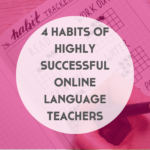Blog Podcast Teach Languages Online
A regular feature on the online language teaching calendar for a few years now is the Online Teacher Summit, hosted by Elena Mutonono. In 2023, I was invited to speak at the event, and chose to talk about how to attract new clients with old content. Let’s take a look at the topic in this article!

How to Attract New Clients with Old Content – Teach Languages Online
Before we get started, you can enjoy this episode in the way you prefer. We’ve got a video version and the podcast below. So pick your place and let’s go!
The Video
The Podcast
My Experience of Updates to Attract New Clients with Old Content
Why I Turned to Old Content
For a lot of 2022, creating new content wasn’t an easy option for me. I was really busy with lots of other things going on that some things had to take a back seat – content creation was one of them.
I decided that seeing as I’d been creating content to promote Lindsay Does Languages pretty consistently since 2014, a break was long overdue to help reset my energy and ideas.
But I didn’t want to go fully radio silent!
So, I chose to use this time to revisit lots of my previous content that I’d created over the years.
As it turns out, that was over 500 blog articles! Some great, some…not so great.
Why All Online Teachers Should Update Old Content Too
You know the feeling, right?
You’re creating new, new, new and it feels like no-one has the time to see and fully take in what you’re making because you feel obliged to always be making & sharing something new.
Well, chances are that if you’ve been teaching online a while now, you’ve got a nice little archive of content that isn’t working as hard as it could be for you.
Take a look at your website’s page views. How many of those page views are from your newest content vs your older & slightly embarrassing stuff?
The older stuff has had longer to exist, be shared more, and build SEO ‘kudos’. There’s definitely something to be said for revisiting it and updating it when people are already finding it.
How to Attract New Clients with Old Content
1) Pause New Content & Audit The Old
First of all, I paused publishing new content to give me some space to audit the older stuff.
This isn’t 100% necessary, but for me it gave me a little space to get the initial audit done and realise what to change and update about my publishing process going forward.
You may like to work with someone who knows their stuff about SEO and content copywriting for this. I worked with Kerry of God Save The SERP.
This isn’t necessary though, and it’s something you can totally do on your own, especially if you don’t have hundreds of pieces of content!
Check for Outdated Content
The first thing I’d recommend is to check for any outdated content. We all have those posts that are really important at one particular time.
For example, ‘Best Languages to Learn in 2012′ or 15 Things All English Learners Need to Learn in 2019’.
Sometimes, these are posts that can be updated regularly, perhaps on an annual basis. If so, be sure to keep a note of this so you remember to do it.
But often, they’re outdated and not bringing in much traffic. In which case, these can be redirected to more relevant content or a 404 page with an email opt in.
For redirections on WordPress, try the plugin ‘Redirections’.
Search Old Keywords
Remember when Periscope was the next big thing? Remember when Vine existed?
Perhaps you wrote a blog called ’17 Ways The Harlem Shake Can Help You Learn Spanish’. Or maybe not.
But you get my point.
If there’s any old keywords that are no longer relevant, these are the next batch of posts you can easily and quickly redirect to something better.
Fix Broken Links
If you use WordPress, add the plugin ‘Broken Link’. This will periodically scan your website for broken links, giving you an easy way to keep track and update them.
You can choose to simply remove links and references to them, or add an updated or more relevant link with this process.
Redirect Embarrassing Old Stuff
If you’ve been using your blog for a long time to promote your online teaching, chances are you’ve got some old embarrassing stuff lingering in the archives!
Maybe getting a puppy was the biggest news and you felt that deserved it’s own blog article in 2013. Well, probably time to let that go.
2) Keep Track of Old Content (and new!) in Airtable
Don’t worry, all of this doesn’t happen chaotically without some kind of order.
The best place I’ve found to organise my content is Airtable.
I love that with Airtable, I can link between tables, include multiple or single select tagging and labelling. Plus the filtering, sorting, grouping and different viewing options are really helpful.
I have to give credit here to the wonderful Katy Prince, who shared the initial template that I adapted for these purposes. She’s just glorious!
When you set this up, you’ll want to include tables for your Call to Action Library, Affiliate Library, and Content Library. You may also choose to split the Content Library to an Upcoming Content Library and a Published Library.
Call to Action Library
This is where you’ll save variations of the copy you use within your blog content (or YouTube videos/podcasts etc!) that expresses your calls to action.
Call to action is marketing speak for “sharing what people should do next if they want to learn more from you”.
For example, if you’ve got courses or products that are available for enrollment all year round, you’ll want to include some calls to action for these.
If you’ve got free opt ins, this is another thing you’ll want calls to action for too.
The point of your Call to Action Library is that you don’t want things to be the same every single time.
Mixing up your copy here keeps things fresh! And, you can link between the records here with your content table so you know exactly which pieces of content have which calls to action.
Affiliate Library
Next up is your Affiliate Library.
This is where you’ll want to keep tabs on the companies & people you are an affiliate for (if any).
As with your Call To Action Library, you can link across to your main content library and keep track of where and how often you mention each affiliate link.
This is useful if you want to track how well each affiliate link is doing too.
SEO Words Library
If you use WordPress, I recommend the plugin AIOSEO, which will help you with your SEO as you update (and create new) content.
One thing that I found tricky however is figuring out which words would score highly for SEO in blog titles as there was no easy list.
It simply tells you whether you’ve included ‘common’, ‘uncommon’, ’emotional’, and ‘power’ words…but doesn’t give you any lists of what it considers these words to be!
So, as I’ve gone through the process of updating, I’ve also made note of SEO Words it lists as each, to save time with each new updated blog.
No more racking my brain to remember what they were!
Content Library
And this is the big one!
Here you’ll keep a record for each piece of content on your website/YouTube channel/podcast feed.
You’ll be able to see which calls to action and affiliate links are included at a glance, as well as whatever other info you feel is useful.
I recommend including columns for:
- Content Type – blog, podcast, video
- Direct Published URL – the exact URL to access the content
- Redirect URL – if the content has been redirected, note the URL where it redirects to
- Current CTA – link the records from your Call To Action Library here
- Affiliates Mentioned – link the records here from your Affiliate Library
- Links to My Stuff – keep tabs of any links direct to your course, product or service sales pages
- New Brand Images? – I have this as a checkbox to keep up to date on whether or not new style brand images have been created and added to the content
- Notes for Improvement – it’s handy to have a simple text box for each record to jot down any quick notes
- Priority – more on this in the next section!
3) Make a Plan to Improve Old Content
Once you’ve added all content to your Airtable Library and created your setup, it’s time to get the audit started!
In fact, the audit itself is one side of it. The other is updating your old content once you know what needs updating.
It’s up to you to decide how best to tackle this.
Do you work best with smaller pockets of time regularly to get it done?
Maybe you work better with one whole week or so dedicated to this one task?
Or perhaps you’d prefer to hire someone freelance to complete it?
Whichever you choose, there’s no one best way – only what’s best for you.
What I will say here is whichever way you choose, there’s some useful tips I can share.
Prioritise
Include a column in your Content Library to note which pieces of content are a priority to update first.
Obviously you want to start with high priority updates. But how do you decide?
Here’s some guidance to decide which posts are high priority to update:
- Posts with more traffic – check your stats
- Posts that strongly fit your current messaging – if your focus has shifted but there’s some golden nuggets in your older content, these can be a good priority
- Posts that could/should strongly fit your current messaging – perhaps there’s a blog with a great title that would really fit your current messaging, but the content needs quite the overhaul!
Schedule
Whether it’s a solid block of time or regular smaller chunks, schedule your updates into your calendar to ensure it happens.
You don’t want to get halfway through the organisation or audit and then abandon a project with such potential.
Reshare
Don’t be afraid to reshare your refreshed content!
Chances are most people won’t have seen it, and if they have, they may well be grateful for the reminder.
There’s also lots of ways you can make new promotional content to reshare.
For example, with each updating blog article that’s relevant, I include a brand new episode of the How To Learn A Language podcast.
This episode also goes up on YouTube so there’s video being shared there too.
Plus, I’m experimenting with making newer short form content for social media – much of which wasn’t an option when these older original pieces of content were published.
Really the key here is to lose the mindset and inhibition that everything you share has to always be new.
Reward!
I’m not necessarily talking spa day for each update (although, I wouldn’t say no!)
But you do want to ensure you’re rewarding yourself along the way for such a mammoth undertaking.
Perhaps, for every 10 blogs you refresh, you go to work in a cafe one afternoon.
Maybe for every 20, you take a day off.
Your call!
Only you know what’s right for your business and what will feel like a suitable reward for you.








